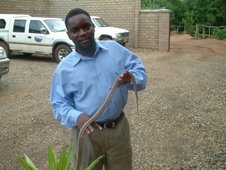
(This article appeared in This is Malawi Magazine)
Mount Mulanje, Malawi's Island in the Sky
by Hastings Maloya
Malawi is very rich in natural resources, which makes it indisputably one of the most beautiful countries in the world. These resources, if put to full potential use, as observed by tourism experts, could complement dwindling foreign exchange earning from agriculture. One such resource that the country needs to be proud of is the Mulanje Mountain.
Situated about 80 km from the commercial city Blantyre, past the green beautiful tea field of the Thyolo Highlands, the attractive Mulanje with its Sapitwa Peak, standing over 3000m above sea level, is not only the highest mountain but also the most impressive and unique massif in the southern and central African region. With its evergreen forests, woodlands and Montane grasslands, the mountain has attracted increasing attention to many tourists.
Mulanje Mountain is much more than a barren rock. Covering an area of 640,000 hectares within Mulanje and Phalombe districts, the mountain has a Forest Reserve thus made up of a range of ecological habitats from rain forest to alpine, woodland to grassland. There is a great diversity of plant and animal life and many of species are endemic. The most famous endemic is the magnificent and endangered Mulanje cedar, Malawi¹s National Tree, which dominates the high altitude forests.
The great variety of wildflowers make the Mulanje grasslands a delight at any time of year but especially during the rainy season, during which time, the plateau is a riot of colour with, amongst many other species, orchids, gladioli and red hot pokers. The Mulanje Massif, apart from its natural beauty, is an important ecosystem. It has stunning forests which are a source of timber and other non-timber resources and home to a rich and diverse endemic plants and animals. The mountain also boasts the presence of hundreds of both localised and migrant bird species
The bird life of this afro-montane habitat is rich and species range from the impressive crowned and black eagles to Malawi¹s only endemic the yellow-throated apalis. The mammals, which include serval cats, hyrax, duiker and bushbuck, are shy and elusive but some are occasionally seen. Two species of dwarf chameleon and several lizard species are only found on this Mountain and in the streams are frogs that also occur nowhere else in the world.
Apart from the famous Sapitwa Peak, there are a lot of striking sites on this massif that has a grouping of lovely hills. Some appealing sites on top of the mountains include the splendid Chambe basin and the superlative Lichenya and wonderful Sombani Plateau. How about the outstanding Rou Gorge and exquisite water falls?
The weather on the top, with the breeze from the natural woodlands, makes the mountain an alternative place worth spending time at. It is therefore not surprising that there are always a lot of people from different parts of the world that visit the mountain with love to appreciate the wonders of nature.
A group of students from England that visited the mountain recently saw the need to leave a comment about the mountain. After what they called 'a three hour task of climbing the hills up to Chambe peak,' the students wrote in a visitor's book:
"What seemed to be a never ending uphill trudge soon led us over the hill to our first view of the beautiful Chambe peak." Three days of their stay in a suitable mountain hut was too little for what they were to see on the mountain. They left with emotive words describing what they saw; "Absolutely gorgeous place that will be described to all of England when we get home. Loved it!"
Bounded by precipitous slopes and a series of discontinuous marginal plateaus, the massif, shared by Mulanje and Phalombe districts is also vital for watershed protection. It is a catchment of headwaters for nine strong rivers in the two districts. Apart from the sturdy perennial rivers, tens of streams have their sources in the mountains. Mulanje Mountain has been managed by the Department of Forestry as a Forest Reserve since 1927.
There are about nine well constructed Mountain huts on the mountain that will offer you a lovely and memorable sleeping time within natural noises and away from hassles. You just need to bring your food and you are safe! Among the well established mountain huts are Lichenya, Chambe, Minunu, Thuchila, Sombani, Chisepo, Madzeka and the CCAP Hut on Lichenya plateau. Well trained and well behaved porters and guides are readily available to assist.
For outdoor enthusiasts, Mulanje offers spectacular hiking on the plateau and peaks, fly-fishing and invigorating swimming in the crystal-clear mountain waters. For the really adventurous there is also serious rock climbing - the west face of Chambe peak provides the chance to undertake 1,700 metres of technical climbing and is the highest rock climb in Africa.
Those that have not been to Mulanje yet, and have not been up onto Mount Mulanje, have not done justice to themselves. Its time they did just that!








1 comment:
Please Sir, If you could Please send me photos of the dwarf chameleons that live in your park.I can tell from reading your articles regarding your respect and concern for your park that you care alot about it,s future.
I live in South Florida USA.
Thank You for your time.
peppi25
Post a Comment